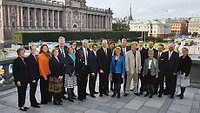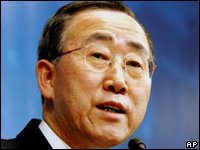When President Bush said “America is addicted to oil”, he could also have said that America is addicted to coal.
Most Americans are not aware of the
sheer scale of current coal use in the United States. Over 50% of electricity is generated from coal with 20 pounds of coal per a person being burnt every day to generate electricity.
While questions are increasingly being raised about remaining oil and gas reserves, we are assured that there is plenty of coal left to burn. Indeed in a talk to a meeting of builders and contractors at the Capital Hilton on June 8, 2005 President Bush asked the audience,
"Do you realize we've got 250 million years of coal?"
Hopefully readers will spot this obvious gaffe. The figure quoted by the coal industry is 250 years of reserves, not 250 million years. The energy illiteracy of the average person is worrying enough, but in our political leadership it is a real cause for concern.
There are an estimated one trillion tons of recoverable coal in the world, by far the largest reserve of fossil fuel left on the planet. The United States has over 25% of the world’s recoverable coal reserves. An important point to remember when considering how many years of coal we have left is that these figures are based on current rates of consumption and do no take into account growing demand for electricity. Since 1980 coal use for power generation has increased by over 75%.
A good percentage of the coal that’s left is too dirty to be burned in conventional power plants and much of its buried in inconvenient places. In 1974 the USGS published an estimate of the recoverable reserve base at 243 billion tons. This however failed to take into account real world restrictions on mining: state and national parks, roads, towns, proximity to railroads, coal quality, losses during mining and geologic limitations. When these are factored in less than 50% of the coal estimated as “recoverable” in the 1974 study was available for mining. This fails to taken into account how much is economically recoverable at market prices. In a 1989 study by the U.S. Bureau of Mines in Kentucky, at $30 a ton 22% of coal was economically recoverable. The author Tim Rohrbacher wrote “a strong argument can be made that traditional coal producing regions may soon be experiencing resource depletion problems far greater and much sooner than previously thought”.
Recently there has been a rise in suggestions that America should replace its addiction to oil, with diesel fuel made from American coal. There is currently in place a Coal-to-Liquids Tax Credit of $0.50/gallon in place until 2023. The idea has been around for a long while, in the second world war it was used by the Germans to make Nazi oil from coal when their supply of normal gasoline was cut off. I remember when I first started researching peak oil I realised after awhile if things got bad that coal rich countries might turn to making Nazi oil in desperation when petroleum depletion started to bite. Of course calls to start building Coal to Liquids plants aren’t proof that petroleum depletion is well advanced, but I hardly see it as a source for optimism.
 Fischer-Tropsch pilot plant
Fischer-Tropsch pilot plant You don’t need to be an expert on coal liquefaction to realise that it’s a bad idea as
this article on AutoblogGreen shows. It’s expensive, uses lots of water, produces double the carbon dioxide when compared to regular petroleum use and produces diesel when the vast majority of the U.S. car fleet runs on gasoline. Over at the Ergosphere, the Engineer Poet crunches the numbers and compares
coal to liquids versus electric vehicles. He calculates that to replace the United States petroleum consumption at current rates would take 214 four billion dollar coal to liquid plants (that’s not far off a trillion dollars in investment) and the mining of an additional one and a half billion tons of coal a year, in addition to the one billion tons already being mined for electricity generation. It should be noted that the high percentage of electricity currently produced from coal is not an argument against electric vehicles, this is something I have covered in detail elsewhere on this blog. Electric motors are inherently more efficient than the internal combustion engine. It is far easier to control emissions from large power plant, than from the exhausts of thousands of cars. Electric vehicles are not reliant on one source of energy and in the longer term polluting non-renewable sources of electricity can be replaced by clean alternative energy.
The coal industry’s promotion of the idea that America has a vast reserve of coal is slowing the transition to clean renewable sources of energy. In addition to tv spots showing
child actors extolling the virtues of coal, the industry has spent heavily to get the ear of the political establishment. According to the Center for Responsive Politics, Peabody Energy, the world’s largest coal company spent over 5% of its revenues on political contributions, for comparison Exxon Mobil and General Motors spent a fraction of one percent.
In seeming return for such generosity, The Energy Policy Act of 2005 included five billion dollars of subsidies for the coal industry.
Virtually every power plant built in America between 1975 and 2002 was fired by natural gas. However between 1970 and 2000, the amount of coal America used to generate electricity tripled.
Now with natural gas prices rising steeply, U.S. power utilities are expected to build the equivalent of 280 500 megawatt coal-fired electricity power plants between 2003 and 2030. China is already constructing the equivalent of one large coal burning power plant a week with two thirds of energy production coming from dirty coal. 16 of the 20 most polluted cities in the world are in China. India is the third largest producer of coal in the world, also getting over two thirds of its energy from coal. If these new coal plants are built, they will add as much carbon dioxide to the atmosphere as has been released by all the coal burned in the last 250 years.
 Acid run off from coal mining
Acid run off from coal miningCoal’s sale price may be low, but the true costs of its extraction, processing and consumption are high. Our use of coal leads to
ravaged mountains, air pollution from acidic and toxic emissions and fouled water supplies. Coal mining is massively more invasive than oil or gas drilling. Coal burning power plants account for more than two-thirds of sulfur dioxide, 22% of nitrogen oxides, nearly 40% of carbon dioxide and a third of all mercury emissions in the United States. Results of the largest mercury hair sampling project in the U.S. found
mercury levels exceeding the EPA’s recommended limit of one microgram of mercury per gram of hair in one in five women of childbearing age tested. Each year coal plants produce about 130 million tons of solid waste, about three times more than all the municipal garbage in the U.S. The American Lung Association calculates that around 24,000 people a year die prematurely from the effects of coal fired power plant pollution.
Techniques for addressing CO2 emissions exist, although the will to quickly implement them lags.
The techniques electric utilities could apply to keep much of the carbon dioxide they produce from entering the atmosphere are known as CO2 capture or geological carbon sequestration. This involves separating the CO2 as it is created and pumping it underground to be stored.
Until recently I wasn’t aware that all the technological components needed for carbon sequestration are commercially ready (according to an article in
September’s Scientific American magazine) as they have already been proven in applications unrelated to avoidance of climate change. However integrated systems have yet to be built on a commercial scale.
Capture technologies have been deployed extensively throughout the world both in the manufacture of chemicals (e.g. fertilizer) and in the purification of natural gas. Industry has gained experience with CO2 storage in operations to purify natural gas, principally in Canada, as well as using carbon dioxide to boost oil production, mainly in the United States.

The Intergovernmental Panel on Climate Change (
IPCC) estimated in 2005 that it is highly likely that geologic locations worldwide are capable of sequestering at least two trillion metric tons of CO2 - more than is likely to be produced by fossil fuel consuming power plants this century.
Carbon sequestration is not without risk. The two main risks are sudden escape and gradual leakage of carbon dioxide. In 1986 at Lake Nyos in Cameroon, Africa carbon dioxide originating from a volcano killed over 1,700 people. However according to IPCC this is unlikely for engineered CO2 storage in carefully selected, deep porous geologic rock formations. In regard to gradual leakage the IPCC
estimated in 2005 that in excess of 99% of carbon sequestered is “very likely” to remain in place for at least one hundred years.
Studies indicate that 85%-95% of the carbon in coal could be sequestered using existing power generation technologies.

A key point is that fundamentally different approaches to carbon capture would need to be pursued for power plants using the old pulverised coal technology as opposed to the newer integrated gasification combined cycle (IGCC). IGCC plants use heat and pressure to cook off impurities in coal and convert it into a synthetic gas, this gas is then burnt in a turbine. These plants are 10% more efficient than conventional plants, consume 40% less water, produce 50% less solid waste and burn almost as cleanly as natural gas plants.
Although building IGCC power plants is slightly more expensive (10%-20%), IGCC is likely to be the most effective and cheapest option for carbon capture.
In an IGCC plant designed to capture CO2 the syngas exiting the gasifier, after being cooled and cleaned of particles, would be reacted with steam to make a gas made up mainly of CO2 and hydrogen. The CO2 would then be extracted and pumped to a storage site. The remaining hydrogen would be burned to generate more power. Captured carbon dioxide can by piped up to several hundred miles to a suitable geologic storage site.
A recent study found that for carbon capture in a saline formation one hundred kilometers from a power plant would cost an additional 1.9 cents per kilowatt-hour (over the generation cost of 4.7 cents per kilowatt-hour for a coal IGCC plant that vents carbon dioxide), making a 40% premium. With coal generation costing 6.6 cents for a kilowatt hour, this would make wind power cheaper than coal and with technology advances could also provide a boost to other renewable energy sources (e.g. concentrating solar power).
However electricity producers are rushing to build conventional coal pulverisation power plants, just as they rushed to build coal plants without sulfur scrubbers prior to legislation coming into force. This is short-sighted as it is more expensive, more energy intensive and less effective to attempt to capture carbon from conventional coal power plants. It is highly likely that having built these plants, that the coal industry would expect the taxpayer to foot the bill for the additional expense. Of the one hundred or so plants being planned or under construction in America only a handful use IGCC technology.
 Proposed Design for FutureGenFutureGen
Proposed Design for FutureGenFutureGen, is the Department of Energy financed one billion dollar zero emissions plant intended to turn coal into electricity and hydrogen. Proposed in 2003 and backed by a consortium of coal and electric companies, it is not due to come online until at least 2013. Many in the industry consider this date to be dubious nicknaming the project NeverGen. It is intended to make it look like the coal industry is doing something, while actually doing very little and in the process putting off changing how coal plants are built for a decade or two. Indeed in its
Coal Vision report(pdf), the industry does not plan on building “ultra-low emissions” plants on a commerical scale until between 2025 and 2035. According to the report “there is considerable debate about the need to reduce CO2 emissions”. The report also states that “achieving meaningful CO2 reductions would require significant technical advances”.
The report further states “large scale and long term demonstrations of carbon sequestration technologies over a geographically and geologically diverse range of... sites are needed before making any policy decisions concerning carbon management”. The coal industry wants sequestration to be demonstrated not only in the United States but additionally “similar assessments need to be conducted internationally”. In terms of who should pay for these demonstrations the report writes “the government must play a significant role”.
It sounds that if the coal industry has its way, it won’t be using carbon capture for many decades.
Instead of waiting until 2013 or even 2035, the coal industry could be building IGCC power plants with carbon capture now. The rush to build conventional coal pulverisation plants is extremely short sighted as these plants could be operating for the next fifty years or more.
In the first instance I advocate maximising our use of clean renewable energy. At the moment wind power is being used to generate only 0.5% of electricity in the United States. Using existing technology wind power could cost effecively generate a significant portion of many countries electricity supply. Significant sums of money should also be invested in making solar power and wave power more cost effective, as well as investments in energy long shots such as cellulosic ethanol and fusion power. If we are going to continue to use coal as global society as a major source of energy, which seems pretty much inevitable for at least the next few decades in key countries such as the United States, China & India, then we should be building IGCC power plants with carbon capture and retiring existing dirty coal plants now. If there are unforeseen problems with carbon capture, we need to find out now rather than in a few decades time. The coal industry's business as usual attitude is simply not acceptable.
Jeff Goodell in his recent book “Big Coal” concludes, “coal gives us a false sense of security, if we run out of gas and oil, we can just switch over to coal… the most dangerous things about our continued dependence on coal is it preserves the illusion that we don’t have to change our thinking”.
Further Reading:
“
Big Coal” by Jeff Goodell
“What to Do About Coal?” in
Scientific American September, 2006Lively Discussion of Coal to LiquidsCoal Vision by the Coal Based Generation Stakeholders GroupMountaintop RemovalA Quick Guide to Mountaintop Removal Coal MiningWhen Will Coal Production Peak?
 For those interested in my approach to the challenges we are facing in the world today, it might be interesting to read the speech I gave to the Swedish Institute for International Affairs on December 19th.
For those interested in my approach to the challenges we are facing in the world today, it might be interesting to read the speech I gave to the Swedish Institute for International Affairs on December 19th.
















